Too many dogs, too few adoptions: Inside the ‘huge crisis’ in KC animal shelters
The KC Pet Project had barely opened for the morning. Aimee Mountjoy trundled in, clasping a leash yanked by a zestful Siberian husky mix. Silver and black, the long-haired dog sniffed ahead frenetically, claws clacking on the floor.
“You guys aren’t going to like me,” Mountjoy, 40, called out to the kennel staff. “I’ve got two more in my car.”
This recent week alone, Mountjoy, a Kansas City good Samaritan known for rescuing huskies — some lost, many abandoned — would bring five dogs to the Kansas City area’s largest kennel, which, like kennels nationwide, is now strained to capacity.
Whatever surge in dog adoptions was wrought by the loneliness and isolation of the COVID-19 pandemic is past.
At animal shelters from the city to the suburbs, more dogs are coming in, sometimes relinquished, but often cast to the streets by their owners. Fewer dogs are being adopted out, placing distraught workers at shelters into an unsettling circumstance. At KC Pet Project near Swope Park, technically a “no kill” shelter, staff members are now euthanizing up to 10 dogs a day that they’d hoped to save.
“It’s a huge crisis. It is,” said Tori Fugate, KC Pet Project’s chief communications officer. “It’s incredible to see how many animals are coming in here right now. We have never seen anything like this in Kansas City before. And it’s not just isolated to Kansas City. Every municipal shelter like ours across the country is seeing this massive intake.”
In July alone, KC Pet Project took in 818 dogs, the most in a single month in the organization’s history.
Stephanie Filer, executive director of Shelter Animals Count, which collects data on 7,000 shelters, has seen the problem rising nationwide.
“Last year, into this year, we’re seeing it. It’s essentially a national crisis,” Filer said. “There are still organizations that are not feeling the impact as much as others, but across the board, everyone’s full.”
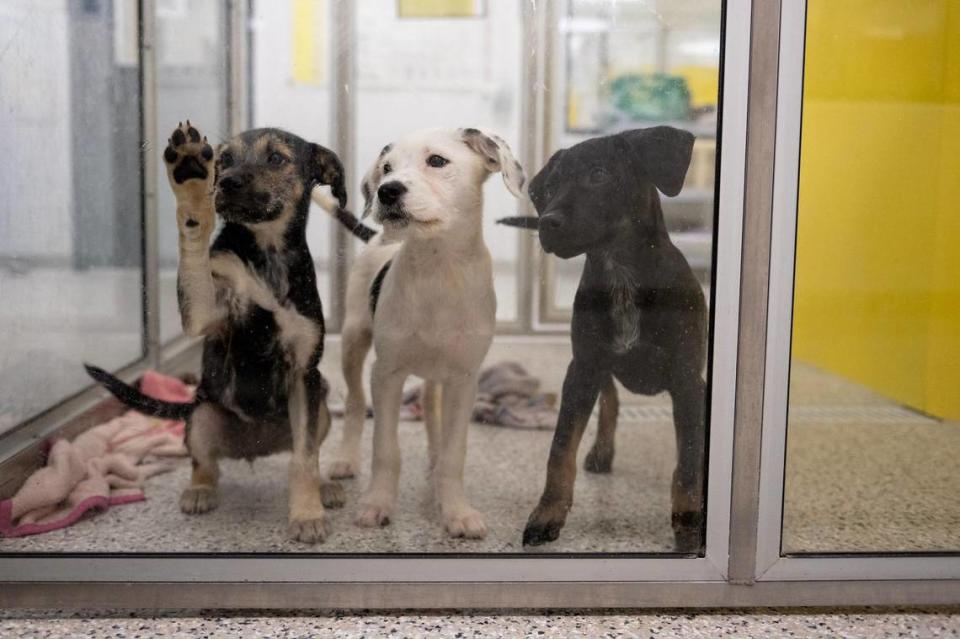
Abandoned and lost
At KC Pet Project, it’s a crisis that’s on display daily. Designed to hold 140 dogs, the shelter has been forced to divide its kennels in half to house more than 300 dogs, not including nearly 150 more in volunteer foster homes.
While many dogs are adopted out each day or retrieved by thankful owners, those numbers pale in comparison to the 30-plus dogs coming through the doors daily.
As Mountjoy left to retrieve the two other huskies, an off-duty Kansas City police officer carried in a chubby beagle mix found wandering behind police headquarters. At 11:30 two nights prior, someone dumped a crate of three black dogs outside the shelter’s gates. Another puppy, black with a white chest, was found tied to a stop sign post at Zona Rosa shopping center.
Just as the officer filled out the beagle paperwork, Kyle Dilley, 31, arrived with a chocolate mutt he found wandering near Kauffman Stadium.
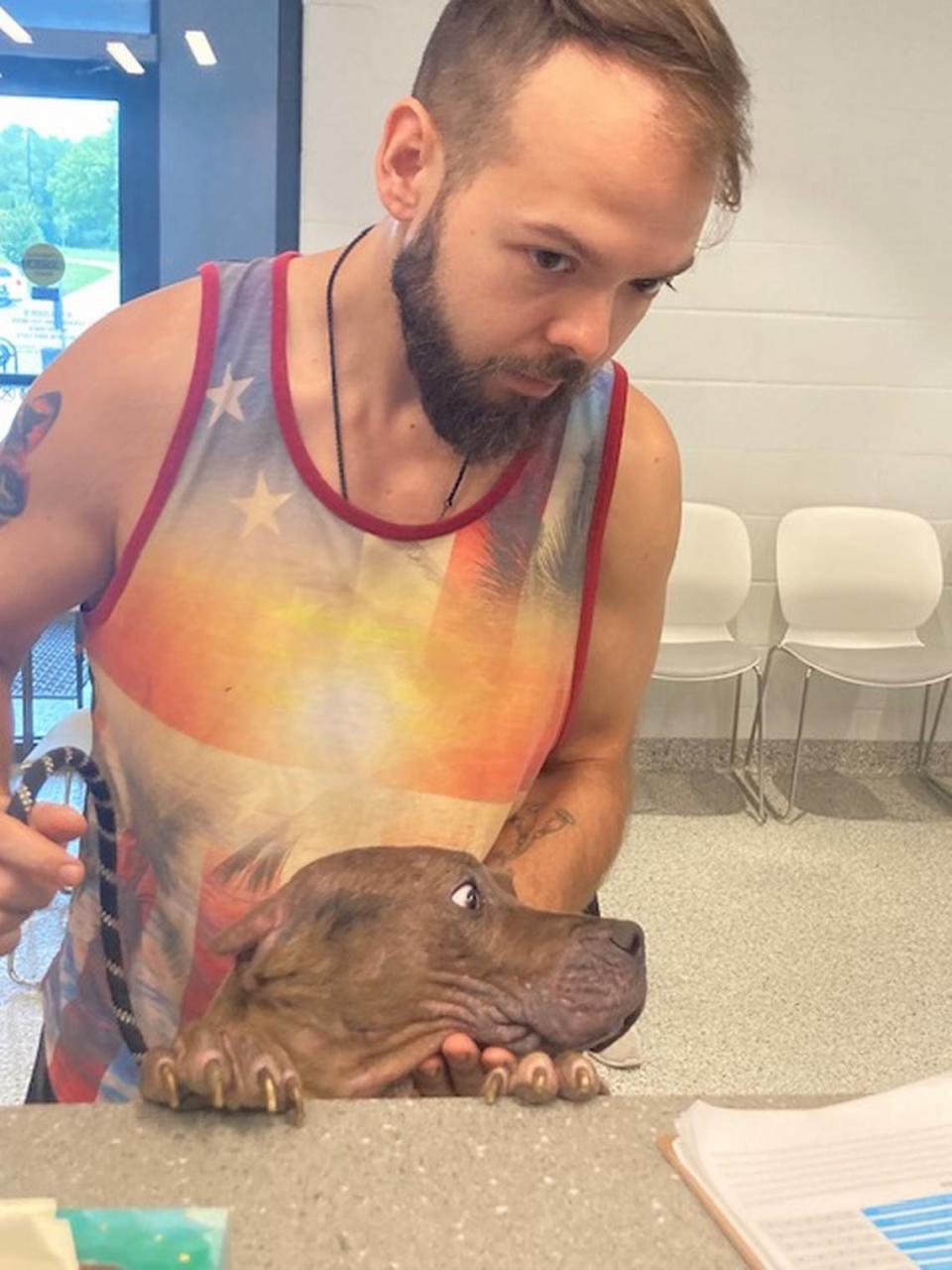
“I was just driving back from my morning coffee shop and just found her on the side of the road,” Dilley said. “Super, super beat up collar, missing patches of fur. Probably hasn’t had the best ownership.”
He gave her food he keeps in his car for his own dogs.
“Super friendly. She ran around behind me and hopped in the car,” he said.
At the shelter, all dogs are checked for implanted microchips. Before being placed in the kennel, they are photographed so their pictures can go on websites. They’re checked for diseases and given shots. If an owner can be identified, workers do as much as they can to return the lost pet. But sometimes owners don’t want them, or can’t afford them. Staff frequently find chips that were never registered or no longer work.
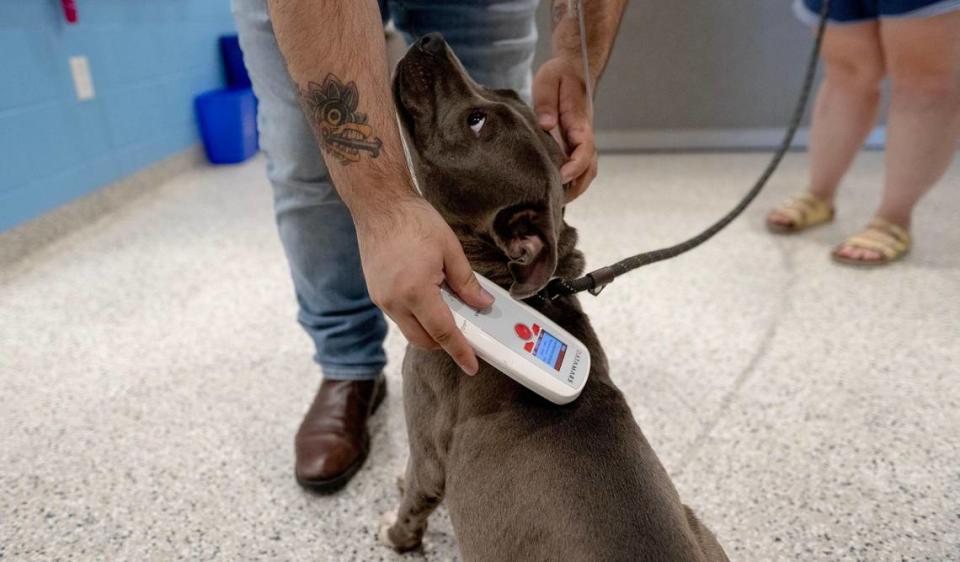
Minutes passed, when on the north side of the building, a van for the Animal Control Division, which KC Pet Project operates for the city, pulled up to unload a family of chihuahuas.
Ryan Johnson, chief of animal services, stepped down from the van. Ashley Peters, the shelter’s intake manager, gathered the dogs in her arms, two at a time. She’s worked at the city shelter for 15 years.
“The last six months, it’s been different than it’s ever been,” she said. “Every time I turn around, there’s dogs in the lobby. I’ll tell you, several years ago, if I took in like 23 dogs, I was like, ‘I was busy.’ Now we’re talking about 35, 38, and it’s rough.”
“Six total,” Johnson said of the chihuahuas. The dogs were removed from a hotel apartment.
“This was a situation where a gentleman was kicked out of a hotel by law enforcement,” Johnson explained. “It was a landlord/tenant issue. He’s currently unhoused. He’s cleaning his stuff out right now.”
The man, Johnson said, told him that he planned to retrieve his dogs. Hopefully that would happen, but often it doesn’t. Problems with housing have become a major issue.
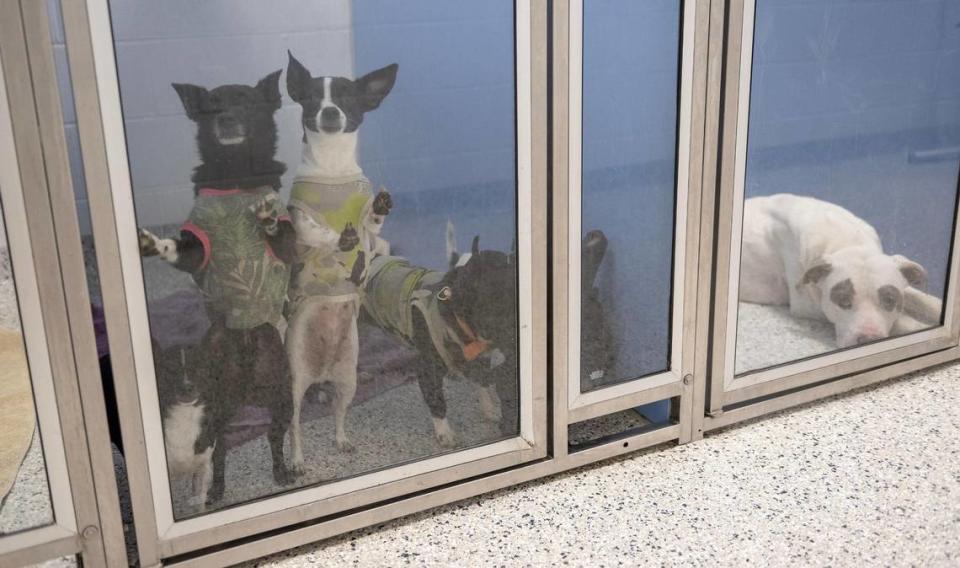
‘I don’t know what to do’
Evicted people mean evicted pets. With nowhere to stay, owners set their pets loose. Those can breed and create more loose dogs. Other owners run against apartment regulations: no dogs, especially bigger dogs. Or else they can’t pay the extra pet fees.
“A lot of it is related to housing,” Filer of the national shelter group said, “particularly the lack of affordable pet-friendly housing for large dogs, or dogs over 25 pounds. Breed restrictions definitely play a role. We’ve seen some landlords that have up to 30 breed restrictions. Dogs that appear to be pit bulls, whether they are or not, are often restricted by landlords or insurance.”
A result is that shelters across the country find themselves populated, sometimes at 80% or more, by what people assume are mixed pit bull breeds. Shelter officials prefer to call them “blocky-headed dogs.” Some may be part pit bull, but as muscular mutts, they may be a mixture of any countless number of breeds from Labradors to bullmastiffs to Boston terriers to who knows?
Shelters are having no trouble adopting out cats and kittens, puppies or smaller dogs. It’s the bigger dogs that are the problem.
Caught in her own housing dilemma, Tracy Arthaloney, 57, of Platte City cried as she walked into the shelter. Her dog, Nakito, squat and round with a pointed, Corgi-like face, panted at her ankle. Peaches, her heather-colored cat, lay in a cat carrier.
Arthaloney approached the desk in tears. “I couldn’t afford my rent,” Arthaloney told the staff.
Living in a studio, she said her rent was raised to $900. She was grateful when she got accepted into federally subsidized housing in Platte City, except she conceded that when she applied for the apartment, she told the complex that she had no pets. But she did. Now the housing manager was saying she was in violation.
“She said I can’t have them on the property until they’re all certified as service companions,” Arthaloney said. “I have to give them up.”
Except, with area shelters packed, that’s no simple task. Platte County has been operating for more than a year without a designated shelter. Arthaloney has no option there. KC Pet Project is so full that the waiting list for dog owners who want to give up their animals now stretches six weeks out.
Not even an appointment would have helped Artholoney. Because she’s not a Kansas City resident, the shelter by city ordinance couldn’t take her pets.
“Now, nobody will take them,” she said. “I don’t know what to do.”
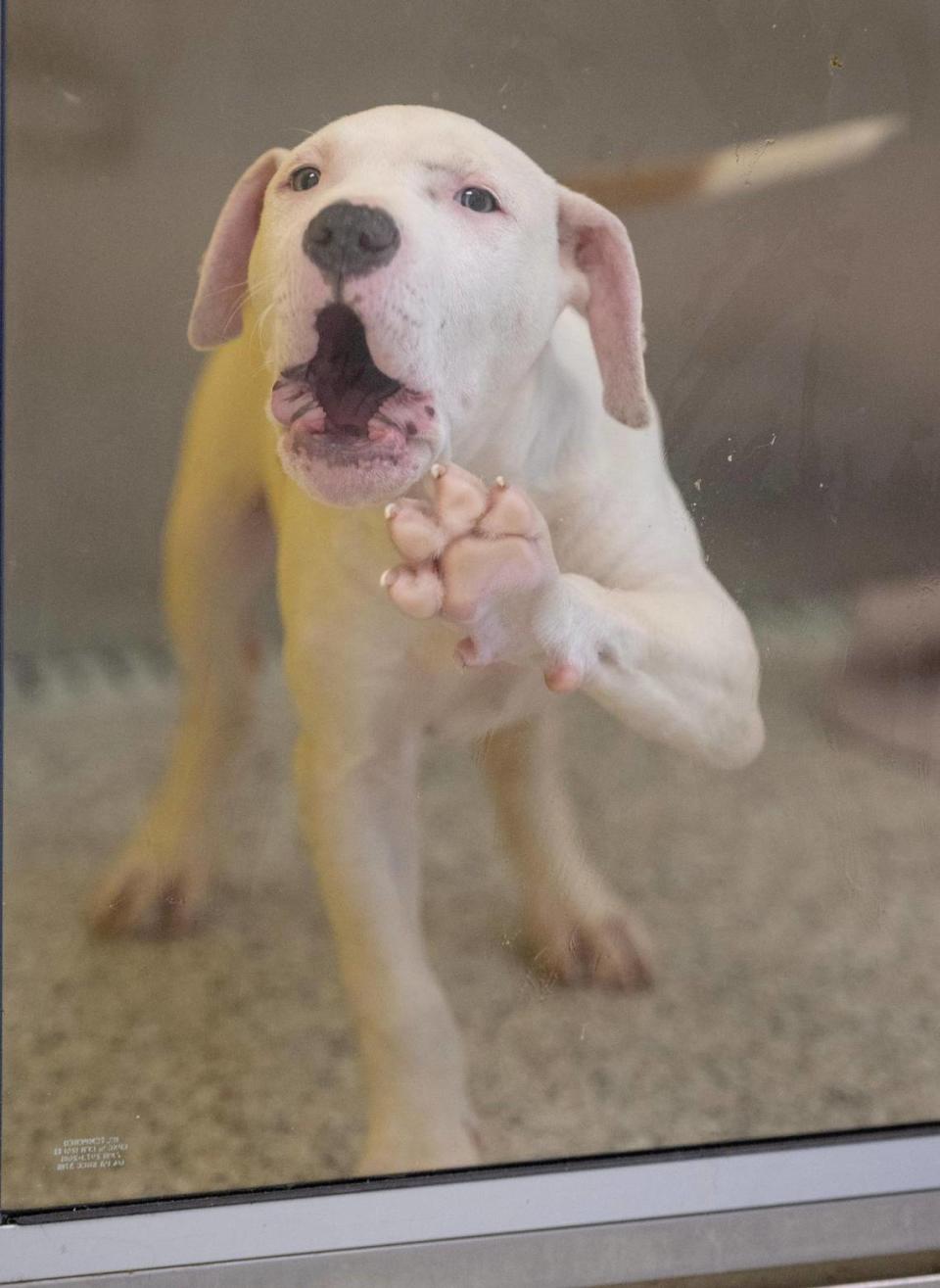
Tears and paw prints
Her grief that day was matched by the staff’s sadness. By nature they are animal lovers, driven to find caring homes for animals, saving them, not losing them. On this day, inside the veterinary exam rooms, they would euthanize nine dogs.
The day prior, they did nine others. Cheetah was the last of the afternoon.
Nathaniel Remines, 35, choked back tears. He sat with the tawny dog, a friendly year-old pit-bull mix, petting him and holding his head in his lap. Cheetah had been found covered in oil nearly two months back, abandoned and tied by his leash to a pillar at a grocery store. Good with people, he was harsh around other dogs.
“I’m sorry, buddy,” Remines, a canine specialist, whispered to the dog. A veterinarian prepared an injection
“The loss of life always hurts, some more than others,” Remines said. “But they all hurt.”
No dog’s life is taken casually. Despite the name, nearly all “no-kill” shelters euthanize some animals. The designation is typically given to shelters where 90% or more of animals are saved, as is the case at KC Pet Project. But even no-kill shelters euthanize animals when they are severely ill or injured, or have behavior problems, such as aggression toward people or other animals that can make adoptions hard if not impossible.
In 2012, when KC Pet Project took over as the city’s shelter, euthanasia numbers plummeted. Before, it had been run by an outfit that killed more cats and dogs than came out alive. The year 2006 was particularly deadly, when 66%, or nearly 7,000 of the 10,440 animals that came into the shelter, were put down, records show.
But in 2013, after the nonprofit KC Pet Project took over, annual adoptions climbed into the thousands while that same year some 565 dogs and cats were euthanized, a fraction of the past. Even in the midst of COVID, the numbers dropped, 254 dogs euthanized in 2020; 209 the next year. It was the lowest in a decade
Except that same year, as COVID waned, something surprising happened. The population of animals taken into the shelter skyrocketed to a level no one expected. Instead of taking in a normal 9,000 to 10,000 animals a year, the shelter in 2021 took in 14,000, a new record. Until last year, when it climbed to 15,000. This year, they’re expected to hit 16,000.
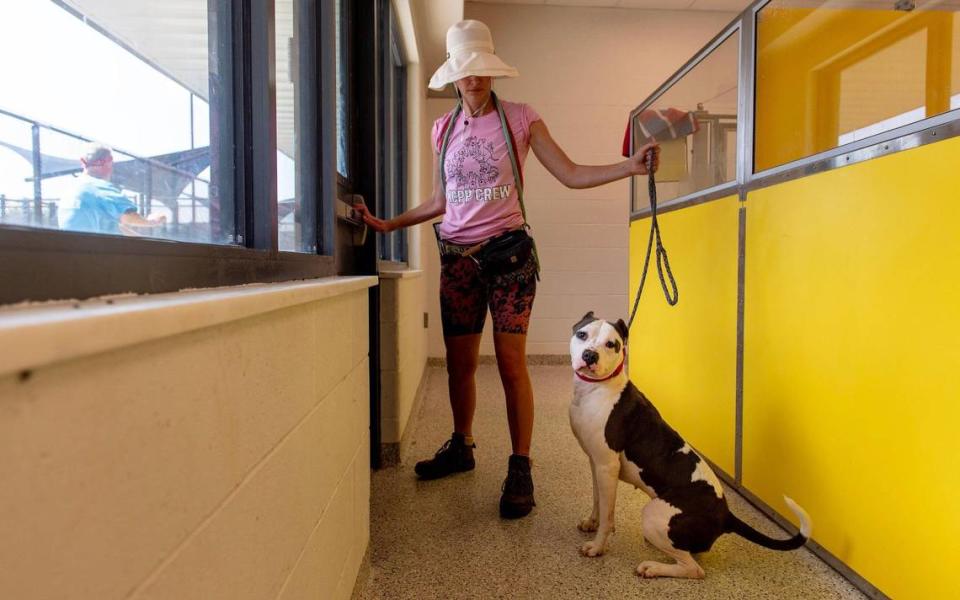
Last year, euthanasia numbers climbed by nearly 50% to 299. In just the first seven months of 2023, the number is 332 dogs, a pace that would reach 570 by year’s end.
The emotional strain could be heard in Tabitha Urban’s voice. Any dog in the shelter there for 30 days or more is put on their “at-risk” list. That list is up to 100 dogs. Dogs in foster care aren’t on the list.
“Today we’ll euthanize nine,” she said. “I’m in the process of creating lists for tomorrow.”
Age 29, Urban is the director of canine operations. The decision to euthanize a dog is made by a team of seven people, who consider everything: the animal’s health, history, its behavior. Can they be with other animals? If not,it’s a problem. To the very end, they work to find owners or someone willing to adopt.
It’s Urban’s job to create the list. Putting healthy dogs to death is not why she got in this business. Her voice welled with emotion. At home, she has six dogs of her own.
“I sit here and I think, for me, it’s just really hard,” she said, “because these dogs can be successful out of this environment. But I’m kind of out of options.
“This is something we’ve never experienced before. I mean I’ve been here six and a half years. I’ve never had to sit down and do 10 forms before.”
The staff treats the moment with dignity. A quiet room. A blanket. Sedation. A volunteer or staff member, “a friendly face” who cared for the dog, Urban said, often sits with the animal. Yesterday, a volunteer went to Sonic at 9:30 a.m. to pick up cheeseburgers for every dog that was being put down.
“A treat prior to saying goodbye,” Urban said.
A veterinarian injected the euthanasia solution into Cheetah’s back right leg. In minutes, he was gone.
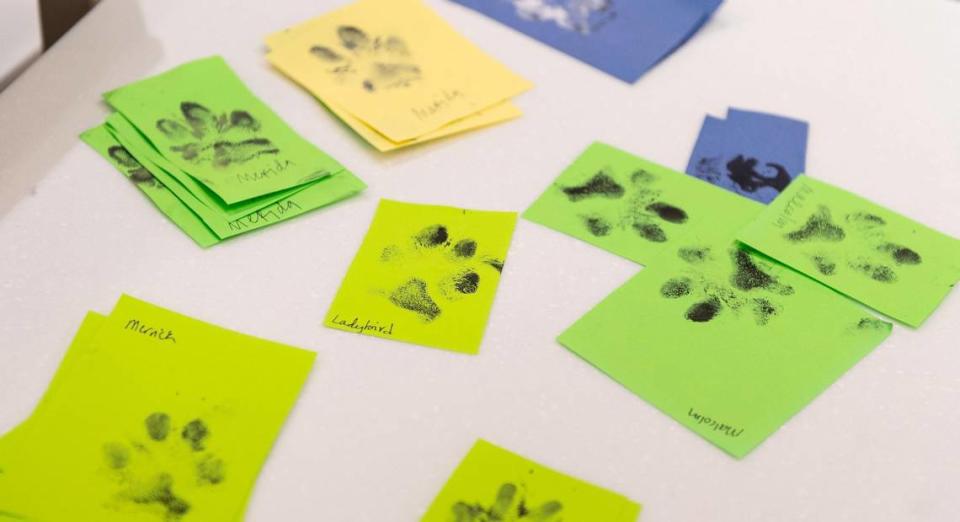
“You OK if I do paw prints?” a co-worker asked.
Yes, Remines said, reflecting on it all.
“A big thing with COVID that a lot of people don’t understand,” he said, “is not only did it affect us, but it affected them (dogs), too. Because with everybody being locked down, everybody went out and got a dog, mostly puppies. But they didn’t socialize them because we were all in lockdown. So now we have all these dogs that are, you know, they can’t be with other dogs because they were never socialized with dogs. They’re great with people. But they’re not good with other dogs.”
They end up here.
“It’s nobody’s fault,” Remines said. “Nobody expected this was even a thing when it was going on. And now, here we are.”
The co-worker inked Cheetah’s paws, pressed them onto pieces of paper for staff and volunteers. She wrote Cheetah’s name near his prints and placed them on a table where those of other dogs, euthanized earlier, were already stacked.
“Something to remember them by,” Remines said.
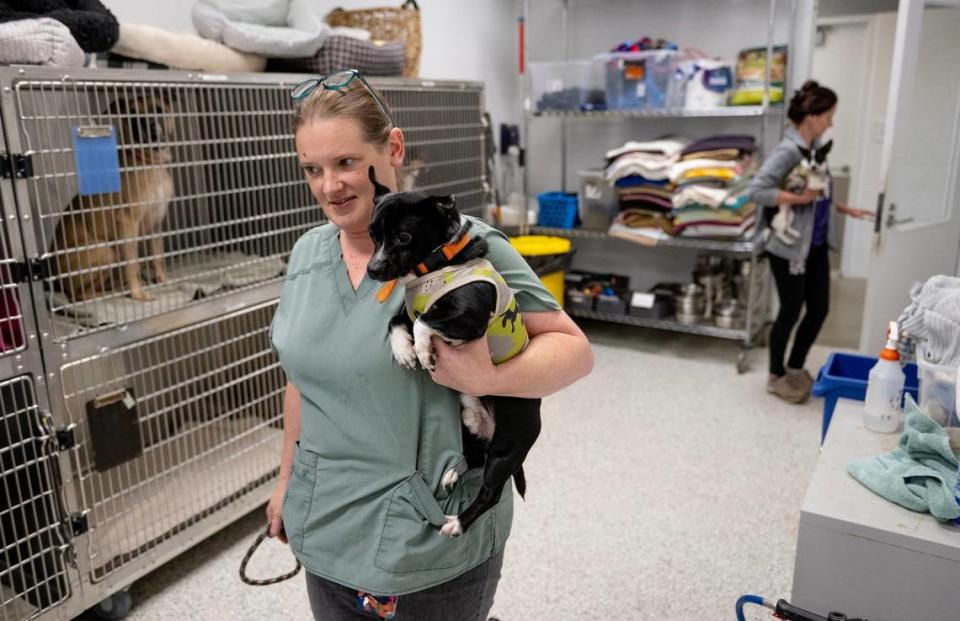
Adoptions and attitudes
In south Kansas City, the nonprofit Wayside Waifs has no time limit for animals in its care. The same holds for Great Plains SPCA in Merriam. A smaller kennel — with room for 75 dogs and 125 cats — it serves seven Johnson County cities, along with the Johnson County Sheriff’s Office and parks department.
Like KC Pet Project, their shelters are no less packed.
“We have more animals coming in, less animals being reclaimed. Adoptions have fallen. So it’s like this perfect storm, if you will, of disaster,” said Erin Morse, the founding director of Midwest Animal ResQ in Raytown. Johnson County is no different.
“If we expanded to 500 kennels, we’d still be full in a week,” said Tam Singer, Great Plains’ chief executive officer. “But that still wouldn’t solve the problem. This is a community problem, not a shelter problem.”
In that, shelter leaders agree. They cite the reasons for so many dogs. Over-breeding to meet the COVID companion demand. Fewer people during lockdown going to veterinarians to spay and neuter. Housing restrictions. Evictions. Hard economic times. Too few veterinarians. The high cost of pet care.
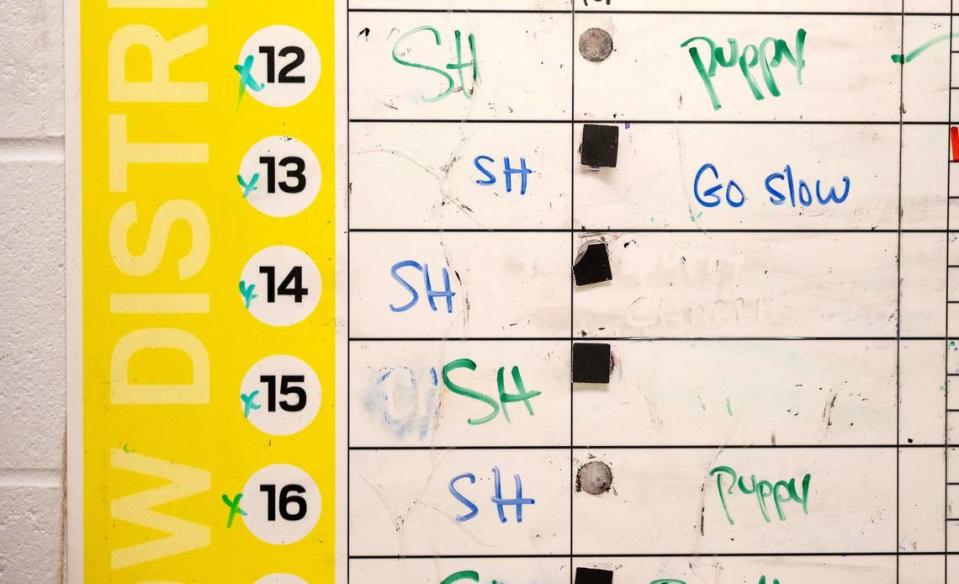
Singer thinks there’s another reason, as well: greater impatience.
“My perspective is that you’ve kind of got this increase in breeding. Then you have this post-COVID society,” Singer said. “It wasn’t that we got tons of returns post-COVID. My opinion is there’s just less patience with pets when they don’t work out.
“We’ve had dogs returned within 30 minutes. We had a dog that got sick in the car and it was returned. Usually, it’s ‘They didn’t like my dog.’ ‘They pooped in the house.’ ‘They peed on another dog.’ They are allergic. I mean, it’s just so quick.
“I was with a puppy that was adopted on a Sunday. A couple hours later I saw them coming back. I think most people are good. Most people have good intentions, but I don’t think we’re even necessarily aware of how much less patience we have with behaviors and stuff.”
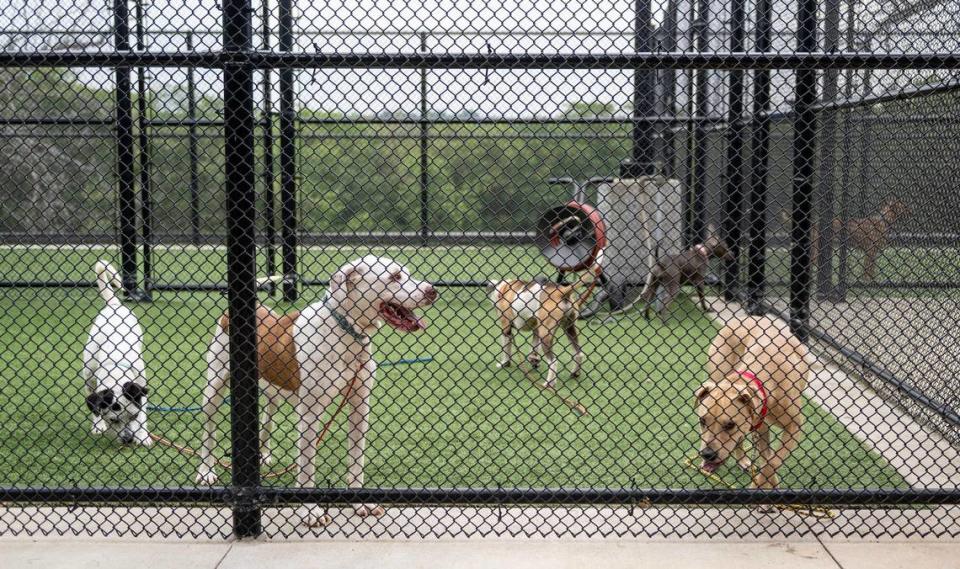
Shelters are working to remedy what they can: lowering the prices of adoptions, providing pet food to food pantries to help those who can ill-afford it. Their goals are more adoptions, more fostering, helping find ways for people to keep their pets at home.
They are grateful for successes.
Sixteen dogs were adopted at KC Pet Project on this day, as part of a $30 adoption special. But 27 came in.
The shelter remains full.
The fresh list would be prepared.
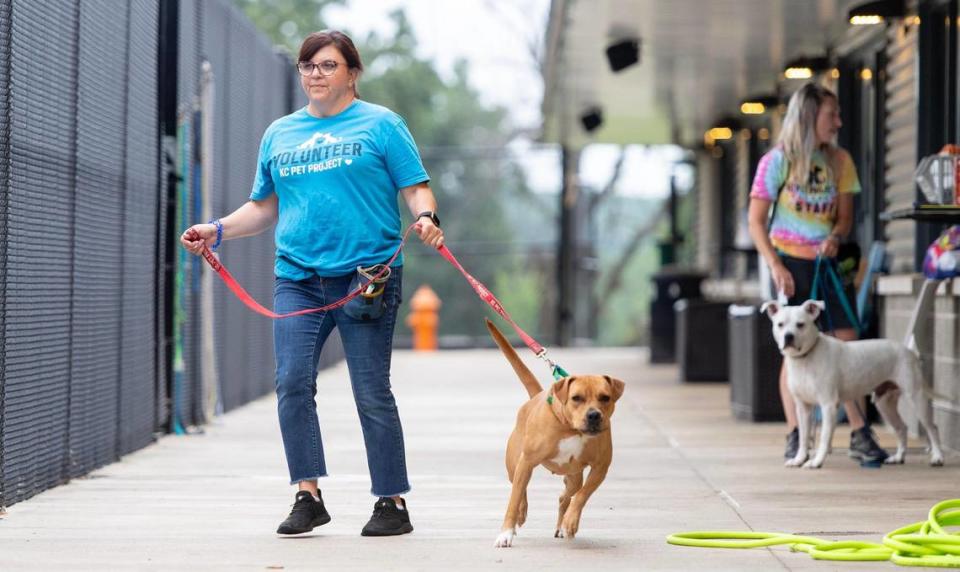
How you can help
Kansas City area shelter leaders offer ways the public can help ease the kennel crisis:
▪ Adopt. Every area shelter posts online photos and stories of pets that need homes. See the list of shelters below.
▪ Foster. Volunteers willing to take larger dogs are in special need.
▪ Volunteer. More animals mean shelters need more help with tasks such as walking dogs or special events.
▪ Help lost animals get back home. If you find a stray, post about it on social media and on sites like Nextdoor, Facebook or Instagram. Getting them home on your own helps keep animals out of already-packed shelters.
▪ Donate. Greater need requires more resources, such as towels to clean up after cats and dogs, medicines and food. At KC Pet Project, the things most needed are kitten supplies, large and extra-large wire kennels, soft treats, and new or used leashes. KC Pet Project publishes its own online wish list. So does Great Plains. Money is always appreciated.
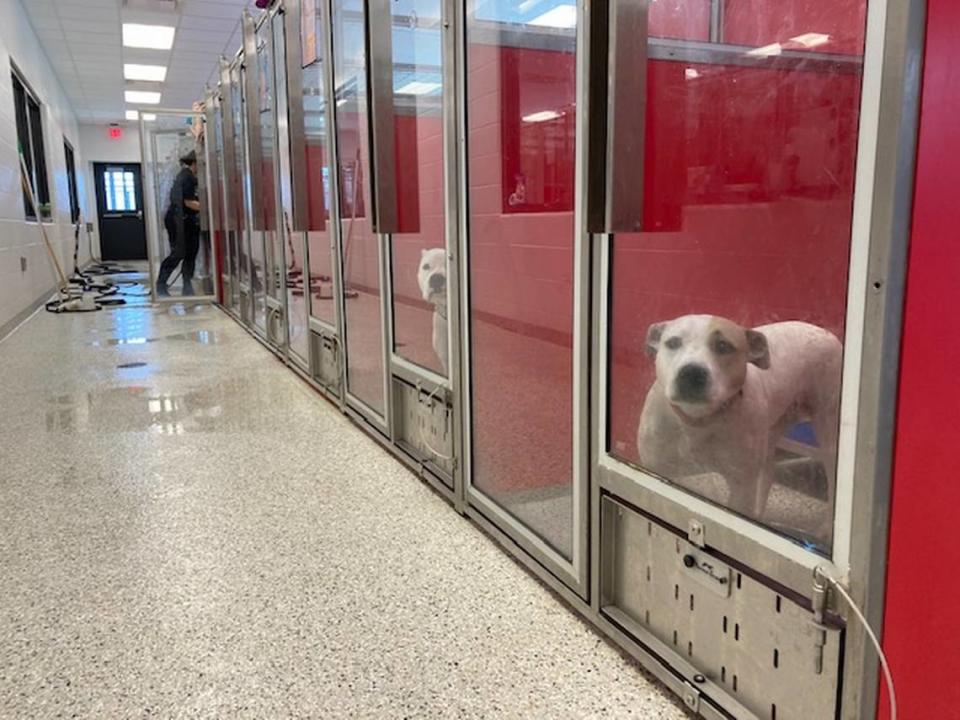
Kansas City area animal shelters
▪ KC Pet Project, 7077 Elmwood Ave., 816-683-1383, kcpetproject.org
▪ Wayside Waifs, 3901 Martha Truman Road, 816-761-8151, waysidewaifs.org
▪ Great Plains SPCA, 5424 Antioch Drive, Merriam, 913- 831-7722, greatplainsspca.org
▪ Melissa’s Second Chances, 11015 W. 75th St., Shawnee, 913-364-1822, mscrescue.org
▪ Human Society of Greater Kansas CIty, 5445 Parallel Parkway, Kansas City, Kansas, 913-596-1000, hsgkc.org
▪ Midwest Animal ResQ, 10312 E. 63rd St., Raytown, 816-919-1364, midwestanimalresq.org
▪ Friends of Parkville Animal Shelter, 1356 Highway 9, Parkville, 816-587-0918, parkvilleshelter.com
▪ City of Liberty Animal Shelter, 2801 Riverview Road, Liberty, 816-439-4791, libertymissouri.gov.
▪ Independence Animal Services, 21001 E. Highway 78, Independence, 816-325-7207, ci.ndependence.mo.us.

